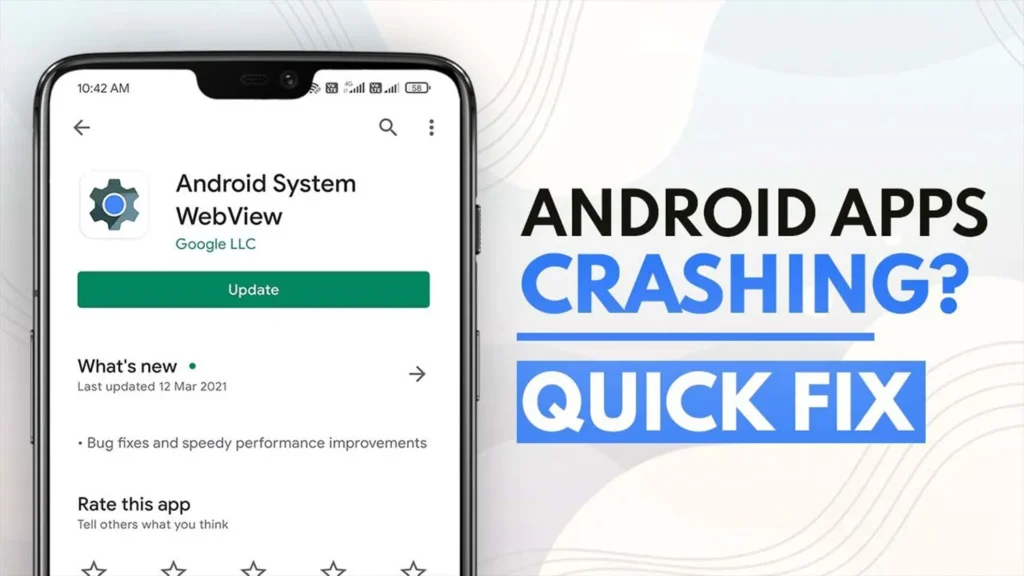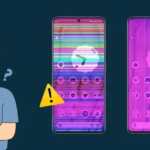How to fix Android App Not Responding Issues Quickly 2024
Description

Experiencing an “Android app not responding” error can be frustrating, especially when you’re unable to pinpoint why apps keep closing or an app won’t open. Our reliance on smartphones means any android app crashing issue can disrupt our daily routine, leading to searching for how to fix crashing apps on Android.
This article will guide you through resolving Android apps crashing problems, from understanding why do apps keep crashing to learning how to stop apps from crashing on Android. Whether it’s a persistent “android app not responding wait or close” message or troubleshooting why an app won’t open on Android, we’ve got you covered.
Table of Contents
What is Android app not responding?
When an Android application stops interacting with user inputs and fails to execute its functions properly, it is often due to an “App Not Responding” (ANR) error. This issue can arise from various underlying problems that disrupt the normal operation of the app. Below are the primary causes:
- Memory Issues
- Occurs when the app runs low on memory, making it unable to process user inputs or operations effectively.
- Code Errors
- If an app encounters an unhandled error within its code, it may freeze or stop responding.
- Slow Processing Time
- Apps processing extensive data or performing complex tasks may become sluggish, leading to delayed responses or errors.
- Unresponsive Third-Party Services
- Apps relying on external services that are currently unresponsive can also become non-functional.
- System Detection of ANR
- Android systems detect an ANR when there is no response to input events such as keypresses or screen taps within 5 seconds. For operations running in the background, such as BroadcastReceivers, the system allows up to 10 to 20 seconds before displaying an ANR message.
To mitigate these issues, it is crucial to maintain the main thread unblocked, utilize background threads for heavy operations, and minimize lock contention between threads. This proactive approach helps in reducing the occurrence of ANRs, thereby enhancing the app’s responsiveness and reliability.
How to fix Android App Not Responding Issues Quickly

Step 01. Restart Your Android Device
Restarting your Android device is a straightforward and often effective method to resolve issues where apps are not responding or crashing. Here’s how you can restart your device to potentially fix these disruptions:
- Standard Restart:
- Press and hold the power button on your device for about 30 seconds or until the device restarts.
- You may need to select the ‘Restart’ option if it appears on your screen.
- Samsung Devices:
- For Samsung smartphones, press and hold the volume down key and the power/side key simultaneously for seven seconds to initiate a restart.
- Devices with Removable Batteries:
- If your device has a removable battery, turn off the device, remove the battery, wait a few seconds, and then reinsert the battery to restart the device.
Restarting can help clear temporary software glitches and connection problems that might be causing the app to malfunction. This simple action refreshes the system processes and can be a quick fix to many common issues related to Android apps crashing or not responding.
Step 02. Update the App and Android System
Step 1: Check for Android System Updates
To ensure your device operates smoothly and the Android app not responding issues are minimized, it’s crucial to keep your system updated:
- Navigate to Settings: Open your phone’s Settings app.
- System Updates: Go to System > Advanced > System update.
- Install Updates: If an update is available, follow the on-screen instructions to download and install.
Step 2: Update the App
Updating the app might resolve android apps crashing or other performance issues:
- Open Google Play Store: Launch the Play Store app on your Android device.
- Manage Apps: Tap on the profile icon, then select ‘Manage apps & devices’.
- Update Apps: Under ‘Updates available’, find the app and tap ‘Update’.
Step 3: Ensure Strong Internet Connection
Before updating, confirm your internet connection is stable to prevent any disruptions during the download and installation process.
Additional Steps
If updating doesn’t resolve the Android app not responding problem:
- Clear Space: Check your device’s storage via Settings. Ensure at least 1-2 GB is free to improve performance.
- Factory Reset: As a last resort, back up your data and perform a factory reset to refresh your device’s system.
By regularly checking for Android updates and keeping your apps up to date, you can enhance device performance and reduce the frequency of app crashes. These updates often include critical bug fixes and enhancements that address compatibility issues and improve overall stability.
Step 03. Clear App Cache and Data
Clearing App Cache and Data
Clearing the cache and data of an app on your Android device can significantly improve performance issues and resolve the ‘Android app not responding’ error. Here’s a step-by-step guide to help you manage app cache and data effectively:
Step 1: Access App Settings
- Open Settings: Swipe down from the top of your screen and tap the gear icon.
- Navigate to Apps: Scroll to and select ‘Apps’ or ‘Applications’ depending on your device.
Step 2: Locate the Problematic App
- Select the App: Find the app that keeps crashing or is not responding. You may need to tap ‘See all apps’ or ‘App info’ for a full list.
Step 3: Clear Cache and Data
- Open Storage: After selecting the app, tap on ‘Storage’ or ‘Storage & cache’.
- Clear Cache: Tap ‘Clear Cache’ to remove temporary files which might be causing the issue.
- Clear Data: Tap ‘Clear Data’ or ‘Manage Space’ followed by ‘Clear All Data’ for a more comprehensive reset.
Why Clear Cache and Data?
- Free Up Storage: Clearing cache helps free up storage space on your device, potentially speeding up other operations.
- Resolve Errors: Clearing data resets the app to its initial state, often resolving errors due to corrupted data.
Note on Data Loss
- Clearing data will erase all the data stored within the app, including settings, login details, and files. Ensure you have backup for necessary information before proceeding.
By following these steps, you can effectively manage app performance issues and mitigate the ‘Android app not responding’ problem, enhancing your device’s overall functionality.
Step 04. Check Your Internet Connection
Step 1: Verify Network Signal
Check for a data indicator (2G, 3G, 4G, H, etc.) next to the signal strength bars on your device to ensure you have sufficient network coverage. A poor network or internet connection can often cause an Android app not responding issue by disrupting the app’s ability to communicate with its server.
Step 2: Optimize Your Connection
If you notice your Android apps crashing or becoming unresponsive, try these steps to stabilize your connection:
- Toggle Airplane Mode: Turn airplane mode on, wait for 10 seconds, and turn it off again. This can help reset your network connection.
- Wi-Fi Connectivity: Ensure Wi-Fi is active. Move closer to the router if the connection indicator shows low signal strength or if the bars are not filled in.
- Restart Your Router: Unplug your wireless router from the electrical outlet, wait for 30 seconds, and plug it back in to refresh the connection.
Step 3: Use Tools to Enhance Connection
- Download a WiFi Checker: Use an app to find and resolve dead spots in your home that might be causing connection issues.
- Contact Your Provider: If problems persist after trying the above steps, reach out to your mobile service provider or internet service provider for further assistance.
By ensuring a strong and stable internet connection, you can significantly reduce the frequency of the ‘Android app not responding’ error and improve your overall app experience.
Step 05. Uninstall and Reinstall the Problematic App
Uninstalling and reinstalling an app is a reliable method to address issues like the Android app not responding, apps keep closing, or app won’t open scenarios. This process can resolve problems stemming from corrupted installations or updates that didn’t install correctly. Here’s a detailed guide to effectively uninstall and reinstall apps on your Android device:
Step-by-Step Guide to Uninstall an App
- Locate the App:
- Navigate to the home screen, app drawer, or device settings under “Apps & notifications.”
- Find the app that is not responding or keeps crashing.
- Uninstall the App:
- Long-press the app icon until a menu appears.
- Tap on “Uninstall” or the trash bin icon.
- Confirm the action if prompted to do so.
Guide to Reinstall the App
- Access Google Play Store:
- Open the Google Play Store app on your Android device.
- Tap the Profile icon, then navigate to ‘Manage apps & devices’ > ‘Manage’.
- Reinstall the App:
- Search for the app you need to reinstall.
- Tap on ‘Install’ to download and install the app back onto your device.
Important Considerations
- Data Backup: Before uninstalling, ensure to back up important data as uninstalling will delete all app data.
- App Compatibility: If the app is not visible in the Play Store, it may have been removed or is not compatible with your device.
- Alternative Installation: In cases where the app is unavailable on the Play Store, it can be installed via an APK from trusted sources.
By following these steps, you can effectively manage and resolve the ‘Android app not responding’ issues by refreshing the app installation, potentially clearing any errors that cause the app to crash or freeze. This method is particularly useful for rectifying android apps crashing due to improper app installation or updates.
How do you fix an app that keeps crashing on Android?

Force Stop and Restart the App
- Access App Settings: Navigate to your device’s settings, select ‘Apps’ or ‘Application Manager’, and find the crashing app.
- Force Stop: Tap on ‘Force Stop’ to terminate the app’s processes. This can resolve temporary glitches causing the app to crash.
Check and Adjust App Permissions
- Review Permissions: Incorrect or denied permissions can lead to app crashes. In the app settings under ‘Permissions’, ensure all necessary permissions are granted.
Clear Cache and Data for Stability
- Open App Info: Go to the app’s information page via settings.
- Manage Storage: Select ‘Storage’, then ‘Clear Cache’ and ‘Clear Data’ to reset the app to its default state.
Update or Reinstall the App
- Update App: Regular updates can fix bugs that cause crashes. Check the Google Play Store for available updates.
- Reinstall: Uninstall the app and reinstall it to refresh its files and settings.
Optimize Device Storage
- Free Up Space: Delete unnecessary files and apps to ensure your device has adequate space to run apps smoothly.
Monitor and Manage Device’s Memory
- Check RAM Usage: Use your device’s memory setting to monitor which apps are consuming excessive RAM and manage them accordingly.
Factory Reset as a Last Resort
- Backup Data: Ensure all important data is backed up.
- Reset Device: Perform a factory reset to erase all data and restore the device to factory settings, potentially resolving deeper system issues causing apps to crash.
By following these steps, you can address and fix issues causing apps to crash on your Android device, enhancing overall performance and stability.
What causes apps to be unresponsive?
Key Factors Leading to Unresponsive Apps
Understanding why apps become unresponsive on Android devices involves examining several technical aspects. Here’s a breakdown of the primary causes:
- Insufficient RAM:
- Apps require a certain amount of RAM to run smoothly. If your device has limited RAM, this can hinder app performance, making them sluggish or unresponsive.
- Processor Limitations:
- The speed and efficiency of your device’s processor play a critical role. Older or less powerful processors can struggle with modern, resource-intensive apps.
- Background Services:
- Numerous system services running in the background can consume significant system resources, leaving less available for your apps.
- Storage Constraints:
- Lack of sufficient storage space can impede an app’s ability to function properly. Apps often need space to create temporary files.
- Software Bugs and Glitches:
- Bugs within the app or the operating system can cause apps to crash or freeze unexpectedly.
- OS Compatibility Issues:
- Sometimes, apps may not be fully compatible with the version of the Android operating system installed on your device, leading to performance issues.
- Corrupted App Data:
- Corruption within app data or improper app updates can result in frequent crashes or unresponsiveness.
- Network-Related Issues:
- Connectivity problems due to unstable internet or network settings can affect apps that rely on online data.
- Resource-Intensive Applications:
- Some apps require more system resources, which can strain the device’s capabilities, especially if multiple high-demand apps are open simultaneously.
By addressing these factors, such as clearing unused apps, updating your system, and checking for sufficient storage, you can enhance the responsiveness of your apps on Android devices.
Why does an app keep closing when I open it?
When encountering the issue where an app keeps closing immediately upon opening, it often presents a frustrating challenge. This behavior can be due to several underlying issues that prevent the app from launching properly. Here’s a detailed exploration of possible reasons and steps to consider:
Step 1: Understanding Immediate App Closures
Immediate app closures typically occur due to conflicts or errors that the app cannot overcome, leading it to shut down to prevent further issues. This might include:
- Corrupted App Files: Corruption in the app’s files can occur due to incomplete updates or external interference.
- Insufficient Permissions: If an app lacks the necessary permissions to operate, it might close immediately after launch.
- Incompatible Updates: Sometimes, new updates are not fully compatible with your device, causing the app to crash.
Step 2: User Options When an App Fails to Respond
When an app fails to launch correctly, users are generally presented with two options:
- Wait for the App to Respond: This allows the app some time to manage the issue and stabilize.
- Close the App: Users can choose to close the app immediately to try and restart it, which might resolve temporary glitches.
Step 3: Seeking Further Assistance
If the problem persists after attempting preliminary fixes such as restarting the device or reinstalling the app, further assistance may be necessary:
- Contact Device Manufacturer: Reaching out to the manufacturer can provide device-specific solutions and additional support.
- Professional Help: Sometimes, professional technical support may be required to diagnose deeper issues with the device or the app.
By understanding these steps and knowing when to seek further help, users can better manage the situation when an app keeps closing unexpectedly, enhancing their overall device experience.
FAQs
1. What should I do if an Android app is not responding?
To resolve an issue with a non-responsive Android app, start by restarting your phone and updating any apps or system software. Specific steps can vary by device, so you may need to consult your device manufacturer for precise instructions. Additionally, you can try force stopping the app via your phone’s Settings app.
2. Why do Android apps stop responding?
Apps on Android may stop responding for several reasons including running out of storage space or losing an internet connection. Ensure your device has adequate storage and a stable internet or data connection to prevent apps from crashing or freezing.
3. How can I fix an Android app that crashes frequently?
To fix frequent crashes in Android apps, follow these steps: Restart your device, check your internet connectivity, update the app and Google Play Services, force stop the app, clear the app’s data, check the app’s permissions, and consider reinstalling the app if the issue persists.
4. What does it mean when an Android app is not responding to user inputs?
When an Android app fails to respond to user inputs, it is typically described as “not responding.” In such cases, a dialog box may appear, giving the user options to either wait for the app to respond or to close the app.
Conclusion
Navigating through the frustration of ‘Android app not responding’ issues, this article has offered a comprehensive guide to quickly and effectively address the problem. From exploring the underlying causes such as memory issues and code errors to implementing practical solutions including app and system updates, clearing cache, and ensuring a stable internet connection, the steps outlined provide a solid foundation for improving app performance. Remember, maintaining your device’s health through regular updates and taking preemptive action can significantly reduce the occurrence of these disruptions.
As we conclude, it’s essential to recognize the importance of these measures not just for resolving current issues but also for preventing future problems. Whether it’s by restarting your device, uninstalling, and reinstalling problematic apps, or any other suggested actions, the goal remains clear: to enhance the user experience and ensure the smooth operation of your Android apps. Embracing these strategies will not only address the ‘Android app not responding’ error but also contribute to the overall functionality and enjoyment of your Android device.














